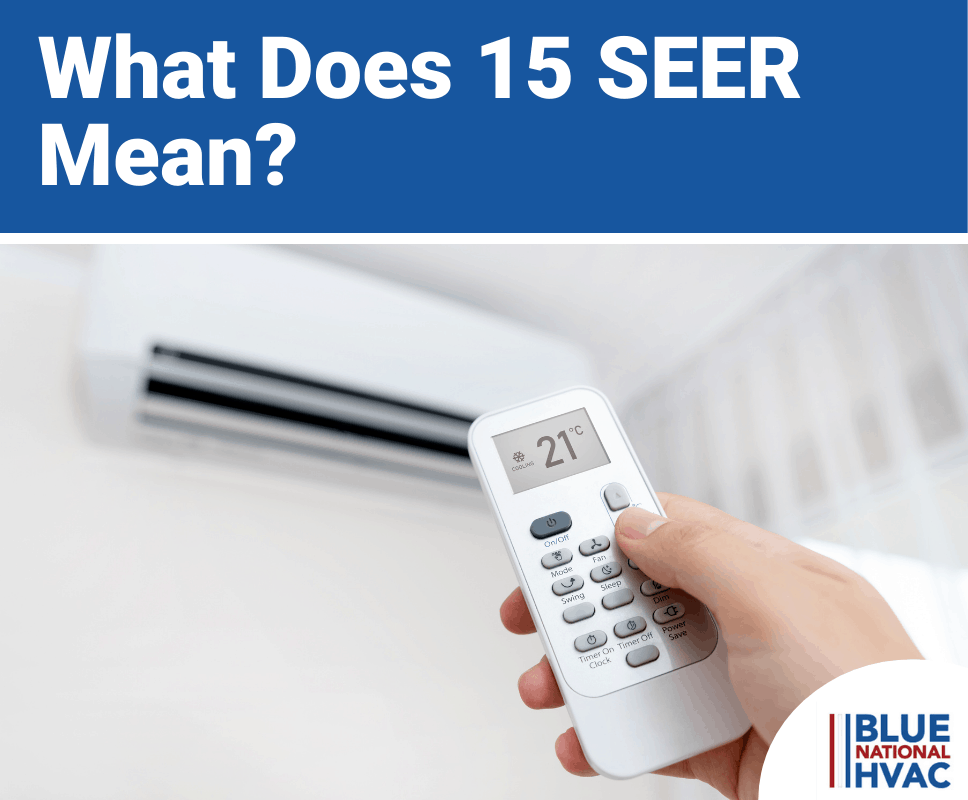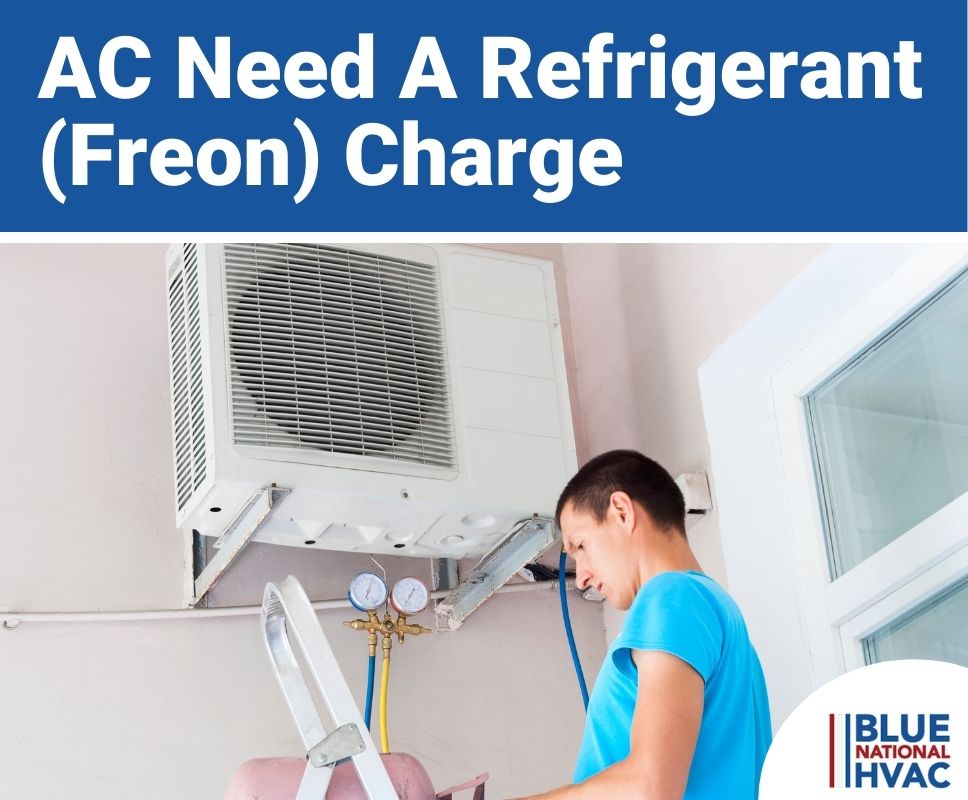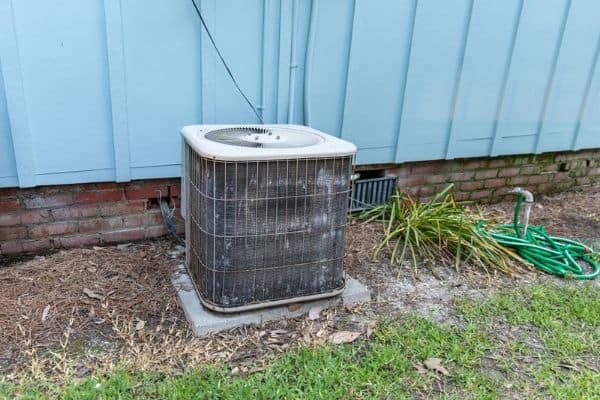What Does SEER Mean in Air Conditioners?
SEER is the Seasonal Energy Efficiency Ratio of an air conditioner. It is a measure of the amount of cooling power produced compared to the total energy it uses over an entire cooling season. A bigger SEER number means the AC unit has better efficiency. For example, a 15 SEER AC unit has a better energy efficiency than a 13 SEER air conditioner.
So, while a 13 and 15 SEER AC unit could provide the same amount of cooling output, the 15 SEER unit uses less energy to do so. All new air conditioners include SEER ratings (or other types of energy efficiency ratings) and higher SEER ratings save energy and lower your electricity bills over time. Including an energy efficiency rating in an AC unit’s specifications makes it easy to compare air conditioners if you plan to upgrade or replace your existing HVAC system.
What Exactly Does 15 SEER Mean?
15 SEER is a specific SEER rating that represents the ratio of the air conditioner’s total cooling output to the total electricity it uses throughout the entire cooling season. 15 SEER units usually include a two-stage compressor and variable-speed blower.
These more advanced components have improved efficiencies compared to single-stage compressors and blowers on lower-rated SEER units.As such, the SEER rating is provided as a specification by the manufacturer, and it is not something you have to calculate or determine yourself.
Is 15 a Good SEER Rating?
15 SEER is considered a good SEER rating because it provides great overall system efficiency. It is one of the most common SEER ratings chosen by homeowners. 15 SEER is popular because it’s a good balance between system costs and energy operating costs.
What Do You Need To Know About SEER in AC Units?
Higher SEER AC units have better energy efficiencies, which means the AC unit will use less power to cool your home and, therefore, will cost less to operate as well.Air conditioners with higher SEER ratings are also more expensive.
They include more sophisticated component parts like two-stage or variable-speed compressors and blowers, which cost more to manufacture.Therefore, if you’re deciding between AC units of different SEER ratings, keep in mind these costs factors:
- Higher SEER AC units are more expensive but will lower your energy bills
- Lower SEER AC units are less costly but will have higher energy bills
How to Find the SEER Rating of an Air Conditioning System
SEER ratings of new air conditioning systems are easy to find. They are usually included on a product or packaging label and the yellow “Energy Star” Energy Guide tag. If you are browsing online and looking at AC units, the SEER rating is commonly indicated in the product title. For example, you will see a phrase such as “4 Ton 15 SEER Central Air Conditioner” alongside the brand and model.
SEER vs EER and COP Ratings
SEER ratings are not the only method to demonstrate the efficiencies of air conditioners and heat pumps. COP and EER are additional ratings you might find on the Energy Star Energy Guide tag. Here is what they stand for:
- COP – Coefficient of Performance
- EER – Energy Efficiency Ratio
COP is the ratio of the heat produced to the electricity used to produce it. COP only applies to heat pumps, which can provide both heating and cooling to your home. Therefore, you will find both a COP and SEER rating on heat pumps.
EER is the efficiency of an air conditioner measured at outdoor temperatures of 95°F (35°C). Unlike SEER, which provides energy efficiency throughout the entire cooling season, EER provides energy efficiency at a single temperature for a single moment in time. With SEER, EER, and COP, more efficient units will have higher ratio numbers.
In other words, in all three efficiency ratings, lower numbers mean the unit is less efficient.SEER can be approximated from an EER by dividing the EER number by 0.875. For example, 14 EER divided by 0.875 equals 16 SEER. The 0.875 ratio is a rule of thumb and can differ depending on the region’s climate and other factors.
Why Is AC Unit Size Important When Choosing A SEER Rating?
When you are looking for a new ac system or a replacement for your current one, SEER is not the only important specification. Air conditioner size is important too! Air conditioner size does not refer to its physical dimensions and weight but rather its overall cooling capacity.
Cooling capacity is the amount of cooling an AC unit can provide to your home. It is critical to size your air conditioner properly so it can adequately do its job without being overtaxed. Air conditioner sizing is measured in tonnage (tons) and British thermal units (BTUs). 12,000 BTUs is equal to one ton of cooling capacity.
The measurement of “tons” for cooling capacity dates back to before electric air conditioners were widely adopted. While SEER is not directly correlated to the size of an AC unit, it is an important part of the selection process of a new 15 SEER AC unit. In fact, if you go to purchase a 15 SEER air conditioner, the first question you’ll be asked is “what size”?
.png)
How Much Do 15 SEER Air Conditioners Cost?
Prices of air conditioners vary widely between the different brands, sizes, and types of units, but if you are already set on purchasing a 15 SEER AC unit, you’ve already narrowed down one factor related to price. Next, you will want to decide the size of the air conditioner you need and the type (central air, ductless mini-split, etc.).
Upfront Costs of 15 SEER Units
Compared to air conditioners with higher SEER ratings, 15 SEER AC units have a lower cost than some. Generally, 13 and 14 SEER (the minimum SEER ratings in the US) air conditioners cost less than 15 SEER systems. However, they use more energy and will increase your electricity bill over time. Air conditioners with a 15 SEER rating are in the sweet spot of affordability and energy efficiency. Here is how much various 15 SEER air conditioners cost on average:
- 2.5-ton central air conditioner: $1800
- 9,000 BTU (0.75 ton) Ductless mini-split heat pump: $600
- 3-ton Air-source heat pump: $2600
- 13 EER (15 SEER), 10,000 BTU window ACT unit: $400
Annual Energy Costs of 15 SEER Units
Calculating an estimated energy cost of a 15 SEER air conditioner is actually quite simple.All you have to do is gather the necessary air conditioner specifications, the local electricity costs, and dust off your calculator.
Here’s how to calculate the annual energy cost assuming a 15 SEER AC unit with a 6,000 BTU per hour cooling output and an electricity cost of $0.26 per kWh:First, we determine the number of kilowatts (kW) of the air conditioner.
6,000 BTU/h 15 SEER = 400 watts or 0.4 kilowatts (kW)
Then you multiply the power (kW) by the electricity cost per hour to determine the price per hour to run the AC unit:
0.4 kW$0.26 per kWh =$0.104 per hour
And finally, to determine the estimated annual energy costs multiply the above cost per hour by the number of days and hours per day the air conditioner will be used. Let’s use 150 days per year and 12 hours per day:
120 days 10 hours per day $0.104 = $124.80 per year
As you can see, an AC unit with a 15 SEER rating is relatively inexpensive to operate. In this case, the total cost of electricity per year is just under $125. For your specific air conditioner and electricity cost, you can use the same formulas. All you have to do is just plug in the numbers for your scenario.
How Does 15 SEER Compare to Higher SEER Ratings?
15 SEER AC units cost less on average than higher SEER rated units of the same cooling capacities. For example, here are the average costs of 2.5-ton central air conditioners with various SEER ratings:
- 15 SEER: $1,800
- 16 SEER: $1,900
- 17 SEER: $2,300
- 18 SEER: $2,500
- 19 SEER: $3,100
- 20 SEER: $3,500+
Additionally, since 15 SEER air conditioners use more energy to provide the same cooling output, they use more energy and cost more to operate per year.Previously in this article, we estimated the annual costs of a 15 SEER AC. Following the same calculations and same assumptions, here is how the average annual energy costs compare between a 15 SEER and a 20 SEER unit:
- 15 SEER: $124.80 electricity cost per year
- 20 SEER: $93.60 electricity cost per year
Therefore, a 20 SEER unit will, on average, provide a 25% lower electricity bill than a 15 SEER unit or an energy savings of $31.20 per year. However, since energy costs are so low, the higher upfront cost of a higher SEER system may not be worth it. Consider this; if you plan to live in your home for 20 years and keep the same AC unit for the time, you will save only $624 if you pick the high SEER air conditioner over the 15 SEER unit (assuming electricity costs and amount of electricity you need stays the same).
When Should You Hire A Professional To Help Choose a 15 SEER Unit?
If you want a further explanation of 15 SEER and help select the best air conditioning system for your home, you should get in touch with one of our professional HVAC technicians to help you assess your unique situation.
.png)
They can go over different brands of equipment, various air conditioner sizes, and the types of AC units that would work for your home. They can help provide air conditioning options to all homeowners and explain the differences between SEER and EER and COP ratings. Our HVAC specialists are easy to work with, helpful, and knowledgeable with all aspects of HVAC systems.If you have questions about SEER ratings, air conditioner sizes, and the various types of AC systems – you should give us a call. We can provide the trust you need and the best recommendations for your home. Most homeowners don’t know a lot about SEER ratings and air conditioner sizes, so our experts are here to help. Whether you’re upgrading or buying a new air conditioning unit or just wanting to learn more, we’ll be waiting!









